ETFs for Rising Interest Rates
One enemy, but an arsenal of weapons
December 2021. Reading Time: 10 Minutes. Author: Nicolas Rabener.
SUMMARY
- A wide range of strategies are marketed as beneficiaries of rising interest rates
- Portfolios are comprised of equities, bonds, options, long as well as short positions
- However, only financial services companies and short bonds offer a positive correlation to interest rates
INTRODUCTION
In this year, most developed markets have been experiencing inflation last seen decades ago, with the exception of Japan. In October 2021, the land of the rising sun had only a 0.1% change in prices, compared to a whopping 6.2% in the US. Consumers are angry, central bankers seem confused, and investors appear wary.
Theoretically, higher inflation should lead to higher interest rates, which makes fixed income a more attractive asset class again. Paying the German government 0.3% for the next 10 years on their treasury note is hardly a desirable investment (read No Longer Superheroes? Twilight of the Bonds).
However, higher interest rates will devalue existing bond positions and lead to higher discount rates, which should lead to lower valuations of stocks. The counterargument is that higher inflation is partially explained by higher economic growth, which should be positive for corporate earnings.
Leaving economics aside, where theory and reality clash consistently, investors are concerned about rising interest rates. The ETF industry has launched a variety of products that may serve to hedge against, or even benefit from rising rates.
In this research note, we will explore ETFs that supposedly benefit from higher interest rates.
ETF SELECTION
Our typical approach to selecting ETFs for a certain theme is going by their product names as that is what most investors tend to do. However, there are only a few ETFs in the US that seem to address rising interest rates going by their names.
Instead, we will focus on a variety of ETFs that often appear in the financial media in relation to rising interest rates. Many of these provide some income, but the reason for these to benefit from rising rates are quite diverse:
- FolioBeyond Rising Rates ETF (RISR / launched in 2021): Interest-only mortgage-backed securities (MBS)
- Simplify Interest Rate Hedge ETF (PFIX / 2021): Put positions on bonds
- Fidelity Low Duration Bond Factor ETF (FLDR / 2018): Short-duration bonds
- Ishares Floating Rate Bond ETF (FLOT / 2011): Floating rate bonds
- Proshares Short High Yield (SJB / 2011): Shorting high yield bonds
- Schwab US REIT ETF (SCHH / 2011): Real estate should benefit from higher interest rates / inflation
- Vanguard Short-Term Corporate Bond ETF (VSCH / 2009): Short-duration bonds
- Proshares Short 20+ Year Treasury (TBF / 2009): Shorting US treasuries
- SPDR S&P Regional Banking ETF (KRE / 2006): Banks should benefit from higher interest rates
- SPDR S&P Insurance ETF (KIE / 2005): Insurance companies should benefit from higher interest rates
- Financials Sector SPDR Fund (XLF / 1998): Banks and insurance companies should benefit from higher interest rates
Some of these ETFs are relatively new, while others were among the first ETFs that came to the market. The time since launch does have an impact on the commercial success as measured by the assets under management, which highlights an ETF market that has become crowded.
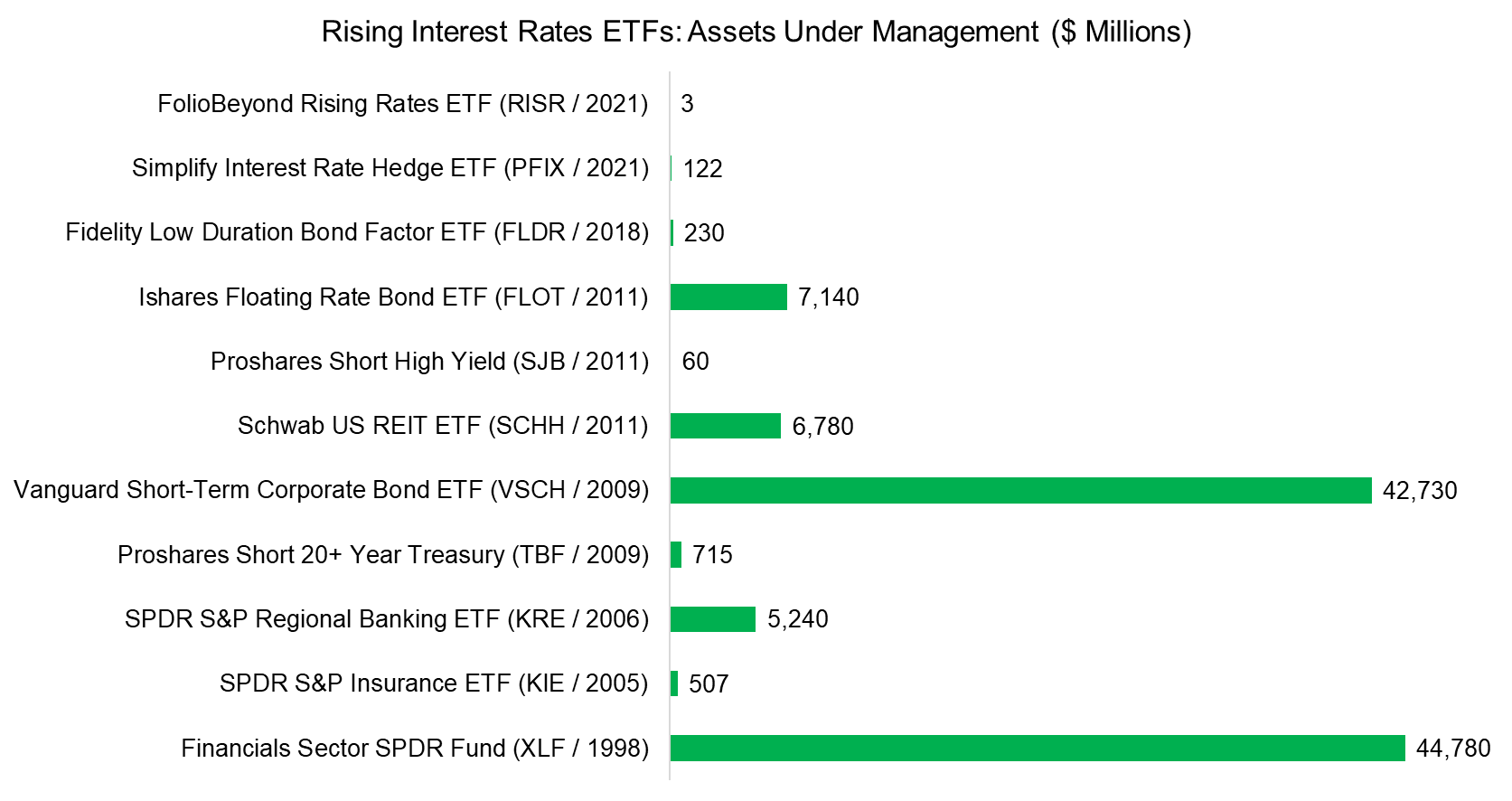
Source: FactorResearch
EXPENSE RATIOS
Typical for ETFs, there is an inverse relationship between fees and assets under management, eg the two ETFs with the lowest fees manage most assets. However, it is worth noting that some of the more recent ETF launches like RISR feature relatively high fees, where the asset manager is betting that its unique strategy justifies these.
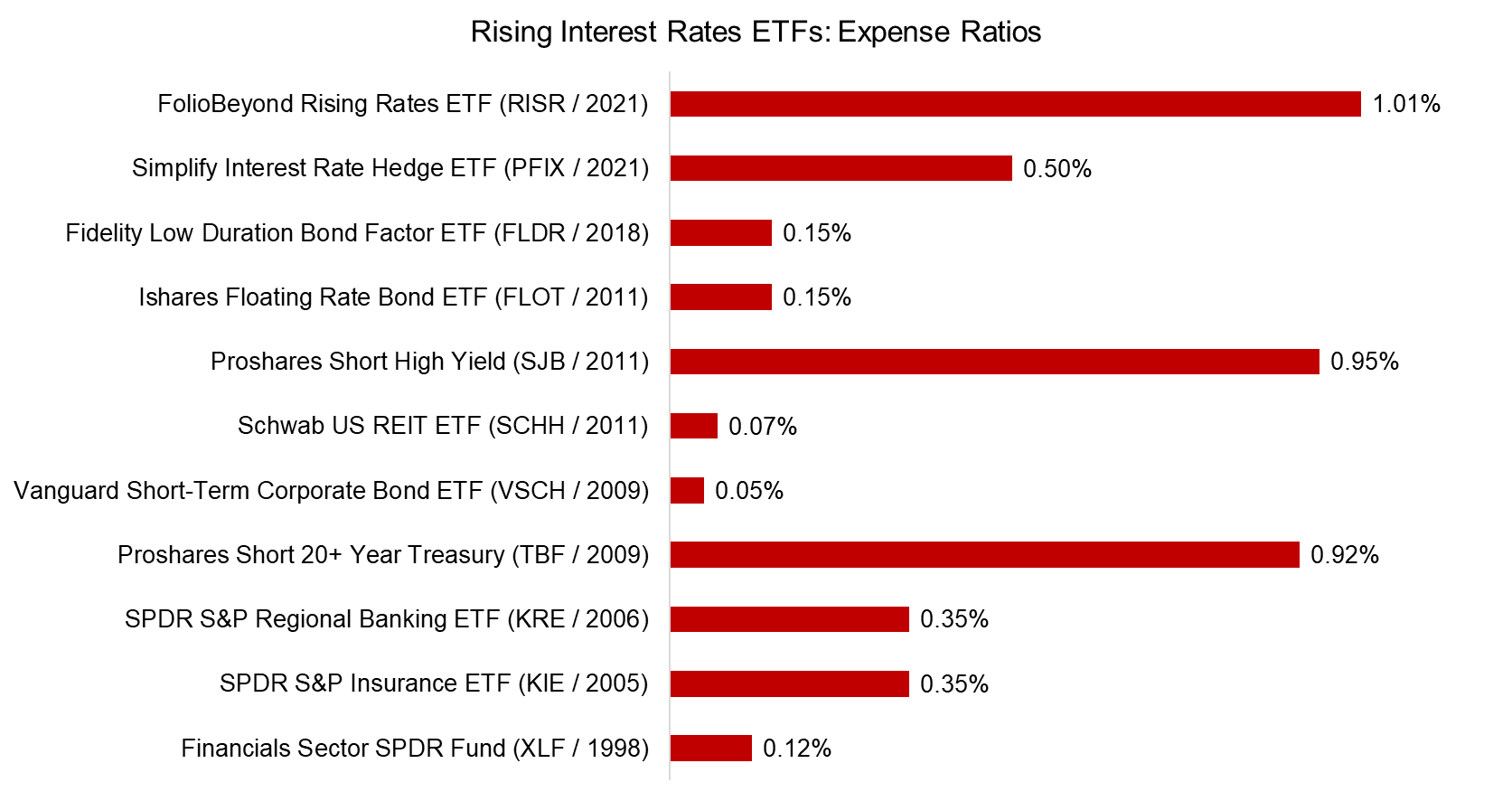
Source: FactorResearch
PERFORMANCE
Reviewing the performance of these ETFs underlines their different strategies. Broadly speaking we can categorize the ETFs into three groups: equity-focused, fixed income, and short fixed income strategies.
It is worth highlighting that the Proshares Short 20+ Year Treasury (TBF) has declined approximately 70% in value since its launch in 2009, but still manages more than $700 million in assets. The returns have been consistently negative given declining government bond yields, which typically leads to redemptions and ultimately the liquidation of the product, but this ETF shows that useful strategies can be commercially successful even with poor returns.
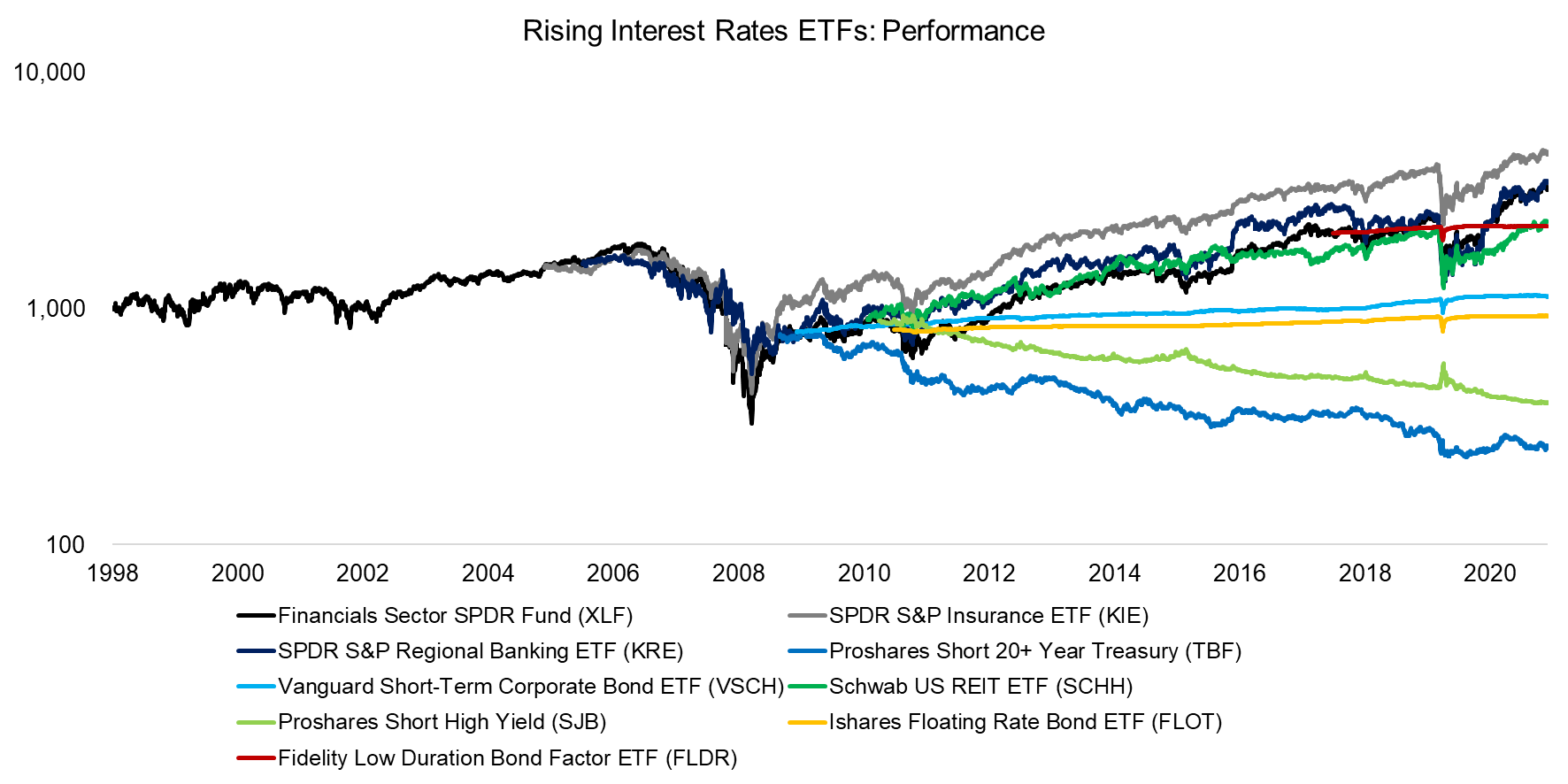
Source: FactorResearch. We exclude RISR and PFIX given a trading history of less than one year.
FACTOR EXPOSURE ANALYSIS
In order to get a better understanding of the diverse strategies, we run a factor exposure analysis on each of the ETFs. As expected, this shows high equity exposure for XLF, KIE, KRE, and SCHH, which are all stock-based portfolios. SCHH also has bond exposure that is explained by the hybrid nature of real estate. KRE has significant exposure to equity factors, specifically the size and value factors.
The two short fixed income ETFs (TBF & SJB) exhibit negative factor exposure to bonds, as per portfolio construction. In contrast, the low duration bonds products (FLOT & FLDR) feature positive bond exposure.
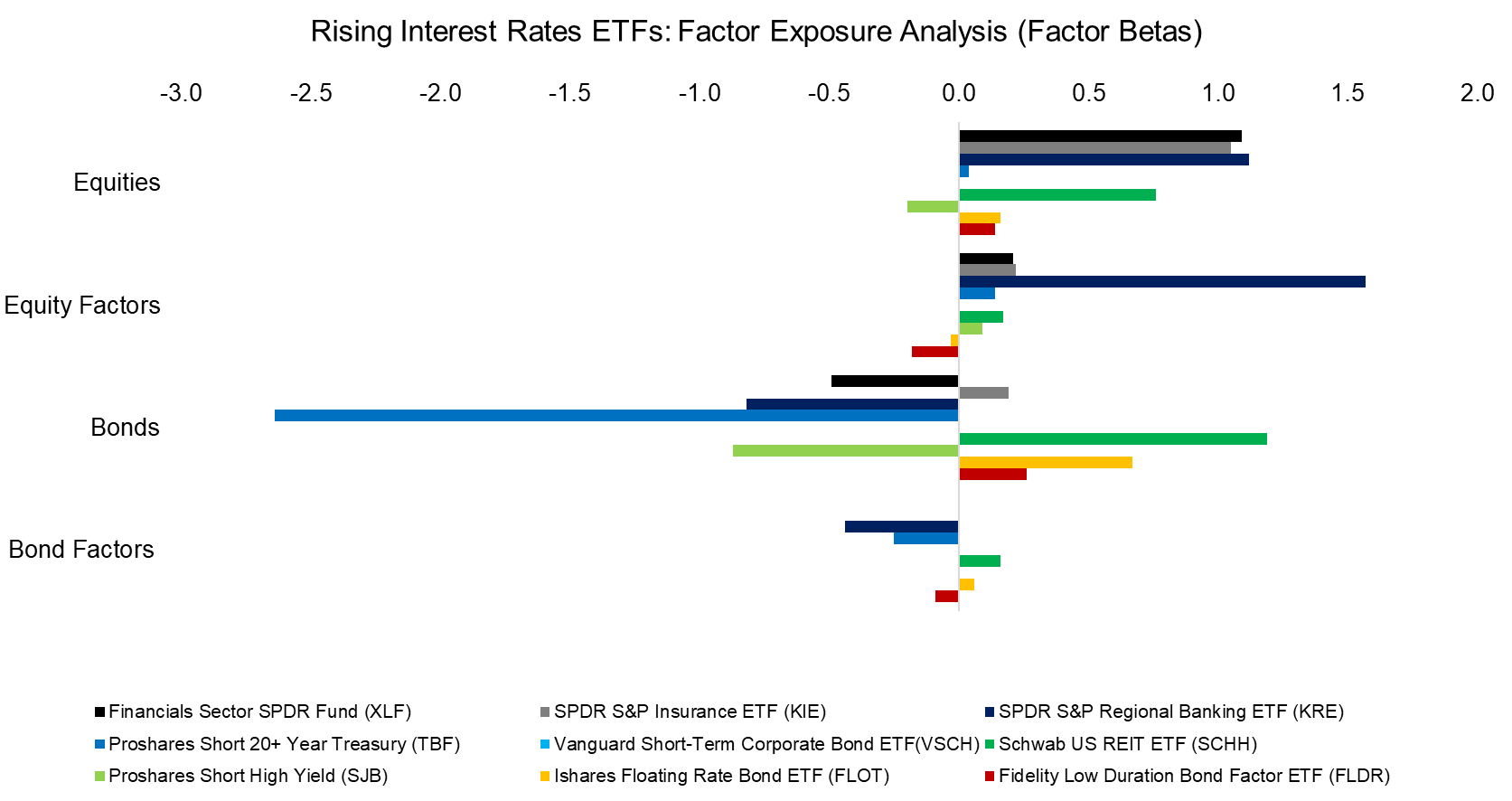
Source: FactorResearch
CORRELATION TO INTEREST RATES
Although it is interesting to analyze the performance and factor exposure of these ETFs, it can be argued that the only relevant metric is their correlation to bond yields. If the correlation is positive, then the ETF will benefit from rising interest rates, although also suffer from declining rates.
We observe that the ETFs providing exposure to financial services companies and short exposure to 20-year US treasuries exhibited the most positive correlation. In contrast, short-duration bonds (VSCH & FLDR) exhibited a negative correlation to interest rates that make less suitable for protecting a portfolio against rising interest rates (read Factors & Interest Rates).
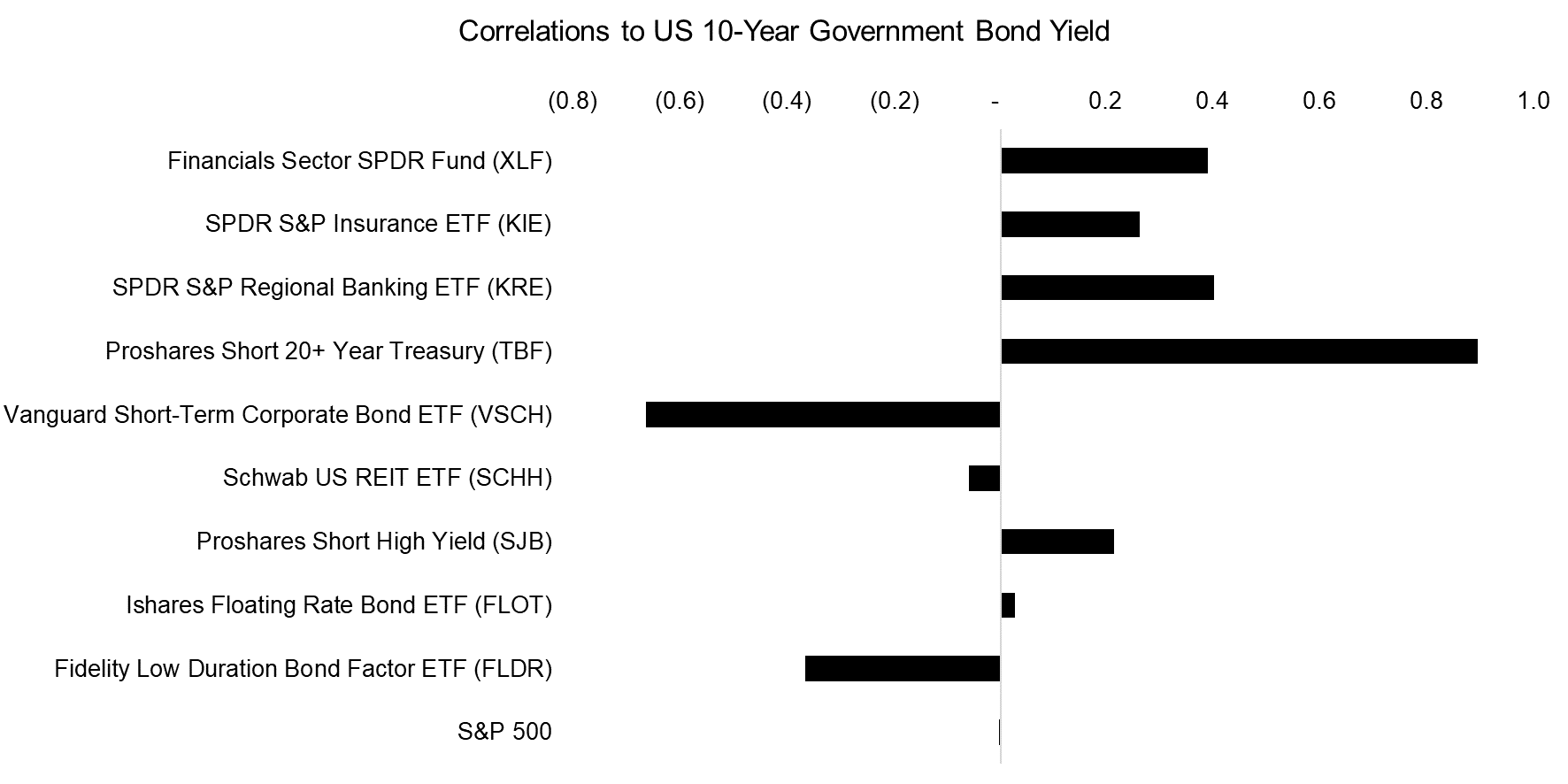
Source: FactorResearch
FURTHER THOUGHTS
Based on this simple analysis, many of the ETFs that are marketed as interest rate beneficiaries seem to have less favourable characteristics than desired. However, measuring the relationship with interest rates can be done in various ways and correlation alone may provide a misleading perspective, eg TIPS have a low correlation to inflation, but are still regarded as suitable instruments for hedging against it.
Furthermore, investors may not only want directional bets on interest rates, ie products that benefit from rising and suffer from declining yields. Some of the newer products focus on providing convexity, which may be more interesting within an asset allocation framework. Given the interest in the theme and crowded ETF space, we will likely see more sophisticated products coming to the market.
RELATED RESEARCH
ABOUT THE AUTHOR
Nicolas Rabener is the CEO & Founder of Finominal, which empowers professional investors with data, technology, and research insights to improve their investment outcomes. Previously he created Jackdaw Capital, an award-winning quantitative hedge fund. Before that Nicolas worked at GIC and Citigroup in London and New York. Nicolas holds a Master of Finance from HHL Leipzig Graduate School of Management, is a CAIA charter holder, and enjoys endurance sports (Ironman & 100km Ultramarathon).
Connect with me on LinkedIn or X.

